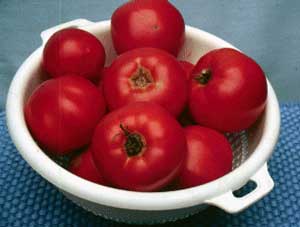When to Harvest
 Tomatoes vary in how long they take to bear ripe fruit from the time they are transplanted into the garden. Early season tomato varieties take 50 to 65 days to harvest. Midseason varieties take from 65 to 79 days, while late season varieties take 80 to 90 days or more.
Tomatoes vary in how long they take to bear ripe fruit from the time they are transplanted into the garden. Early season tomato varieties take 50 to 65 days to harvest. Midseason varieties take from 65 to 79 days, while late season varieties take 80 to 90 days or more.
For optimum flavor do not refrigerate tomatoes. Pick them just prior to eating and use them at room temperature.
Indeterminate plants set fruit until frost. A first light frost is likely to kill the plants while fruit is still ripening and there are still mild, sunny days expected. To prolong their lives, cover the tomato plants when a premature light overnight frost threatens with white polyspun floating row cover (sometimes called “fleece”), sheets, blankets, or plastic.
If a hard frost threatens, pick the tomatoes green and wrap each in newspaper, then allow them to ripen over the next few weeks indoors. This trick works only with perfect, unblemished tomatoes.
Storing Green Tomatoes
Arrange green tomatoes on shelves or in shallow open containers, in single layers. Don’t allow them to touch one another. Then place the containers in an open, airy location at 60° to 70° F, away from direct sunlight. Check for ripe fruit every few days and discard any that show signs of spoiling. The variety ‘Long Keeper’ does not turn red when ripe--it is fully ripe when the skin is a golden orange-red. In some cases fruits can be harvested while still completely green, others have done well stored at temperatures as low as 50° F in cellars, garages, or on porches. Then bright light and warmth hasten ripening.
Tomatoes can be frozen too. Freeze ripe whole tomatoes in plastic bags. Then take what you need and peel them by rubbing the skin off under a stream of hot tap water. They are best used in dishes that are cooked.
Canning Tomatoes
Tomatoes are one of the most popular vegetables for home canning. Because of their high acidic content most tomatoes can be safely processed in a water-bath canner. Select only your best fruits for canning. Avoid overripe, decayed or bruised tomatoes and those picked from dead vines.
Can them with the hot pack method. Add two tablespoons of bottled lemon juice to each quart or one tablespoon per pint. Process pints for 35 minutes and quarts for 45 minutes.
Saving Tomato Seeds
Saving Tomato Seeds For Next Year.
This trick works only for open pollinated seeds; does not work with hybrid seeds. Select one or two of the best examples of the tomato variety you wish to save; it should be very ripe. Cut the tomato in half and with a spoon scoop out the seeds into a jar of some kind. To avoid any contamination, wash your hands and use a clean spoon and clean jar for this task.
Notice the seeds are surrounded by a jelly like substance. You want to ferment the seeds to get rid of that jelly. Add a cup of water to the jar with the seeds and set it in a warm spot such as the top of the fridge – 70 degrees to 80 degrees is ideal. A mold will form on the surface of the water and the stuff will smell pretty bad. After three days, take a strainer and slowly pour off the mold, floating seeds, and any other debris. Clean off the strainer and now pour the good seeds, that don’t float, into the strainer and wash them thoroughly to get rid of the jelly; stir them around in the running water.
To dry these cleaned seeds, lay them on a clean plate in one layer. Over a period of a week or so, stir them around from time to time to make sure they dry evenly on both sides. When they slide easily around on the plate, store the seeds in a paper envelope and be sure to label the envelope with the variety name.

